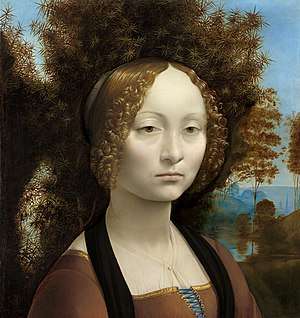Ginevra de' Benci
| Ginevra de' Benci | |
|---|---|
 | |
| Artist | Leonardo da Vinci |
| Year | c. 1474–8 |
| Type | Oil on panel |
| Dimensions | 38.1 cm × 37 cm (15.0 in × 15 in) |
| Location | National Gallery of Art, Washington, D.C. |
Ginevra de' Benci is a portrait painting by Leonardo da Vinci of the 15th-century Florentine aristocrat Ginevra de' Benci (born c. 1458).[1] The oil-on-wood portrait was acquired by the National Gallery of Art in Washington, D.C. in 1967. The sum of US$5 million—an absolute record price at the time—came from the Ailsa Mellon Bruce Fund and was paid to the Princely House of Liechtenstein. It is the only painting by Leonardo on public view in the Americas.[2]
Subject
_-_Google_Art_Project.jpg)
Ginevra de' Benci, a well-known young Florentine woman, is universally considered to be the portrait's sitter. Leonardo painted the portrait in Florence between 1474 and 1478, possibly to commemorate Ginevra's marriage to Luigi di Bernardo Niccolini at the age of 16. The juniper bush that surrounds Ginevra's head and fills much of the background, serves more than mere decorative purposes. In Renaissance Italy, the juniper was regarded a symbol of female virtue, while the Italian word for juniper, ginepro, also makes a play on the sitter's name. The imagery and text on the reverse of the panel further support the identification of this picture. The reverse is decorated with a juniper sprig encircled by a wreath of laurel and palm and is memorialized by the phrase VIRTVTEM FORMA DECORAT ("beauty adorns virtue").
The Latin motto VIRTVTEM FORMA DECORAT on the reverse of the portrait, is understood as symbolizing the intricate relationship between Ginevra's intellectual and moral virtue on the one hand, and her physical beauty on the other. The sprig of juniper, encircled by laurel and palm, suggests her name. The laurel and palm are in the personal emblem of Bernardo Bembo, a Venetian ambassador to Florence whose platonic relationship with Ginevra is revealed in poems exchanged between them. Infrared examination has revealed Bembo's motto "Virtue and Honor" beneath Ginevra's, making it likely that Bembo was somehow involved in the commission of the portrait.
The portrait is one of the highlights of the National Gallery of Art, and is admired by many for its portrayal of Ginevra's temperament. Ginevra is beautiful, but austere; she has no hint of a smile and her gaze, although forward, seems indifferent to the viewer.[3]
A strip from the bottom of the painting was removed in the past, presumably owing to damage, and Ginevra's arms and hands were lost. Using the golden section, Susan Dorothea White has drawn an interpretation of how her arms and hands may have been positioned in the original.[4] The adaptation is based on images of hands by Leonardo that are thought to have been executed as studies for this painting.
Trivia
- As a woman of renowned beauty, Ginevra de' Benci was also the subject of ten poems written by members of the Medici circle, Cristoforo Landino and Alessandro Braccesi, and of two sonnets by Lorenzo de' Medici himself.
- According to Giorgio Vasari, Ginevra de' Benci was also included in the fresco by Domenico Ghirlandaio of the Visitation of Mary and Elizabeth in the church of Santa Maria Novella in Florence, but it is now believed that Vasari made a mistake and that Ghirlandaio painted Giovanna Tornabuoni.
- Ginevra's brother Giovanni (1456-1523) was a friend of Leonardo's. When Vasari wrote his Lives, Leonardo's unfinished Adoration of the Magi was in the house of Amerigo Benci, Giovanni's son.
- In 2017, the researcher and cryptographer Carla Glori anagrammatized fifty Latin sentences signed VINCI, formed with the very same alphabetical letters of the motto VIRTVTEM FORMA DECORAT when supplemented with the Latin word iuniperus (juniper [sprig]).[5] Glori argues that the anagrams form a coherent text and have a meaning that unequivocally refers to the portrait and to the biography of Ginevra Benci.
References
- ↑ "Ginevra de' Benci". National Gallery of Art. D.C. Retrieved 16 November 2014.
- ↑ "Leonardo da Vinci's Ginevra de' Benci" Archived 21 December 2005 at the Wayback Machine. National Gallery of Art. Washington, D.C. Retrieved 5 June 2013.
- ↑ Brown (2003)
- ↑ White, Susan D. (2006). Draw Like Da Vinci. London: Cassell Illustrated. ISBN 9781844034444, pp.114-115.
- ↑ Glori, Carla. "The Story of Ginerva de' Benci". Academia. Retrieved November 16, 2017.
For an unorthodox view on Ginevra de' Benci see: Paratico, Angelo (2015). Leonardo Da Vinci: A Chinese Scholar Lost in Renaissance Italy. Lascar Publishing. ISBN 978-988-14-1980-4.
Sources
- Hand, J. O. (2004). National Gallery of Art: Master Paintings from the Collection. New York: National Gallery of Art, Washington. ISBN 0-8109-5619-5. p. 28.
- Brown, David Alan (2003). Virtue and Beauty: Leonardo's Ginevra de' Benci and Renaissance Portraits of Women. Princeton University Press. ISBN 978-0-691-11456-9.
External links
| Wikimedia Commons has media related to Ginevra de' Benci by Leonardo da Vinci. |
- Ginevra de' Benci at the Web site of the National Gallery of Art
- Leonardo da Vinci: anatomical drawings from the Royal Library, Windsor Castle, exhibition catalog fully online as PDF from the Metropolitan Museum of Art, which contains material on Ginevra de' Benci (see index)